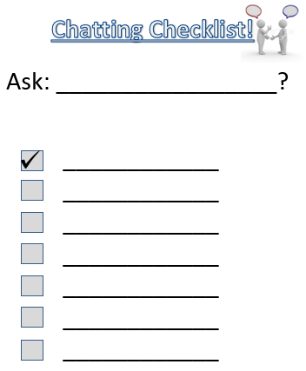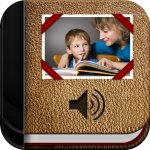Working on Conversational Skills at Home
Having conversations is an important skill to socially connect with people! Many of our teen and adult students work on social communication goals, working on the ‘rules’ of having successful conversations such as staying on topic, maintaining conversation, asking partner-directed questions and turn-taking. Below are some exercises to work on some of these skills at home! Click here to download materials for each of these exercises.
1. Topic Boards, Cards and Webs!
- Use topic boards or cards and take turns choosing different topics to chat about. That way, your student gets practice talking about a variety of topics, things they want to talk about, and things other people want to talk about.
- To remind them of the topic, write it at the top of a piece of paper while you chat. You can let your student know if they remained on or off topic.
- Use topic webs to brainstorm different talking points about that topic.
- Use apps like Tiny Decisions (Free) to create your own topic wheels to choose a topic!



2. Sentence Strips and Question Starters
- If your student needs support generating questions or you want to lessen cognitive demands, script questions you could practice asking each other.
- Having supports such as sentence strips or wh-question starters (e.g. who, what, where, when, etc.) can help you get started.

3. Chatting Checklists
- Come up with a daily or weekly question and create a checklist of people you want to practice asking!
- Or during your conversations, choose a relevant question they asked to put on their chatting checklist to practice asking various peers or family members throughout the week.

4. Commenting
- Making comments shows others that we are listening to what they are sharing with us and lets them know how we feel about what they shared.
- You could practice commenting when sharing about your day, photos or talking about TV shows you’re watching – really anything of interest!
- Have a visual reminder of various comments you can use within your conversations with others.

5. Question and/or Comment Tally
- During your chats, keep a tally of the number of follow-up questions and/or comments you each ask. Count them up and celebrate! This can be very rewarding for students.
- It also gives them practice visually seeing and feeling what it’s like to take turns and have more balanced conversations.


6. Using Pictures or Picture Apps
- Make your student the photographer and take pictures of what you do! Many of our students ask more questions, are more likely to elaborate and can recall past events more accurately when they have pictures to refer to during conversations.
- Apps like Pictello or Picture Calendars like MemoryAid are also great for allowing students to use pictures to generate questions and short narratives about recent events they have experienced.
7. Social Stories
- Social stories can be a great tool for learning and reminding students what is expected when we converse with others. The social story, “Having Conversations” is an example of one, which highlights many of the social ‘rules’ that are expected during conversations such as greeting, staying on topic, asking questions, making comments, and taking turns.

